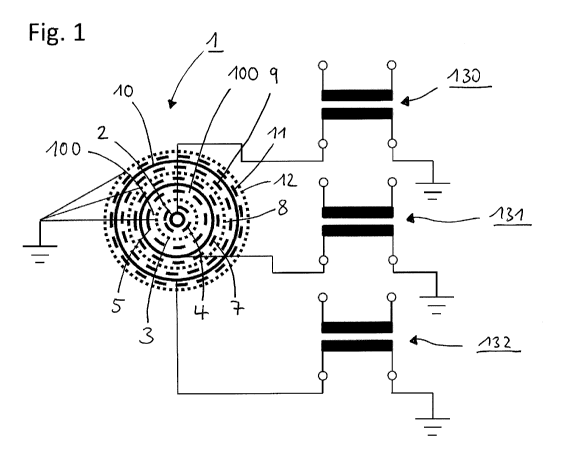Some of the information on this Web page has been provided by external sources. The Government of Canada is not responsible for the accuracy, reliability or currency of the information supplied by external sources. Users wishing to rely upon this information should consult directly with the source of the information. Content provided by external sources is not subject to official languages, privacy and accessibility requirements.
Any discrepancies in the text and image of the Claims and Abstract are due to differing posting times. Text of the Claims and Abstract are posted:
| (12) Patent Application: | (11) CA 3089675 |
|---|---|
| (54) English Title: | COMPACT OZONE GENERATOR WITH MULTI-GAP ELECTRODE ASSEMBLY |
| (54) French Title: | GENERATEUR COMPACT D'OZONE AYANT UN ENSEMBLE ELECTRODE A MULTIPLES ESPACES |
| Status: | Examination Requested |
| (51) International Patent Classification (IPC): |
|
|---|---|
| (72) Inventors : |
|
| (73) Owners : |
|
| (71) Applicants : |
|
| (74) Agent: | SMART & BIGGAR LP |
| (74) Associate agent: | |
| (45) Issued: | |
| (86) PCT Filing Date: | 2019-01-25 |
| (87) Open to Public Inspection: | 2019-08-01 |
| Examination requested: | 2024-01-25 |
| Availability of licence: | N/A |
| (25) Language of filing: | English |
| Patent Cooperation Treaty (PCT): | Yes |
|---|---|
| (86) PCT Filing Number: | PCT/EP2019/051864 |
| (87) International Publication Number: | WO2019/145479 |
| (85) National Entry: | 2020-07-27 |
| (30) Application Priority Data: | ||||||
|---|---|---|---|---|---|---|
|
The invention relates to a device for generating ozone from oxygen-containing gas by silent electric discharge with electrodes which are installed in a nesting manner with at least two high-voltage electrodes (2,6,10) and at least one ground electrode (3,8,12), wherein between each high-voltage electrode (2,6,10) and ground electrode (3,8,12) a dielectric (4,5,9,11) is arranged, and wherein at least two discharge gaps (100) are formed, which are traversed by the gas, wherein a different voltage is applied to each single gap (100) according to the individual gap width.
La présente invention concerne un dispositif de production d'ozone à partir de gaz contenant de l'oxygène par décharge électrique silencieuse avec des électrodes qui sont installées d'une manière imbriquée avec au moins deux électrodes à haute tension (2, 6, 10) et au moins une électrode de terre (3, 8, 12), un diélectrique (4, 5, 9, 11) étant disposé entre chaque électrode à haute tension (2, 6, 10) et électrode de terre (3, 8, 12), et au moins deux espaces de décharge (100) étant formés, le gaz passant à travers ces derniers, une tension différente étant appliquée à chaque espace unique (100) selon la largeur d'espace individuelle.
Note: Claims are shown in the official language in which they were submitted.
Note: Descriptions are shown in the official language in which they were submitted.

For a clearer understanding of the status of the application/patent presented on this page, the site Disclaimer , as well as the definitions for Patent , Administrative Status , Maintenance Fee and Payment History should be consulted.
| Title | Date |
|---|---|
| Forecasted Issue Date | Unavailable |
| (86) PCT Filing Date | 2019-01-25 |
| (87) PCT Publication Date | 2019-08-01 |
| (85) National Entry | 2020-07-27 |
| Examination Requested | 2024-01-25 |
There is no abandonment history.
Last Payment of $277.00 was received on 2024-01-19
Upcoming maintenance fee amounts
| Description | Date | Amount |
|---|---|---|
| Next Payment if small entity fee | 2025-01-27 | $100.00 |
| Next Payment if standard fee | 2025-01-27 | $277.00 |
Note : If the full payment has not been received on or before the date indicated, a further fee may be required which may be one of the following
Patent fees are adjusted on the 1st of January every year. The amounts above are the current amounts if received by December 31 of the current year.
Please refer to the CIPO
Patent Fees
web page to see all current fee amounts.
| Fee Type | Anniversary Year | Due Date | Amount Paid | Paid Date |
|---|---|---|---|---|
| Application Fee | 2020-07-27 | $400.00 | 2020-07-27 | |
| Maintenance Fee - Application - New Act | 2 | 2021-01-25 | $100.00 | 2021-01-15 |
| Maintenance Fee - Application - New Act | 3 | 2022-01-25 | $100.00 | 2022-01-21 |
| Maintenance Fee - Application - New Act | 4 | 2023-01-25 | $100.00 | 2023-01-20 |
| Maintenance Fee - Application - New Act | 5 | 2024-01-25 | $277.00 | 2024-01-19 |
| Request for Examination | 2024-01-25 | $1,110.00 | 2024-01-25 |
Note: Records showing the ownership history in alphabetical order.
| Current Owners on Record |
|---|
| XYLEM EUROPE GMBH |
| Past Owners on Record |
|---|
| None |